§ May 10, 2012
Studio-to-Market
I've been looking for ways to streamline the process of getting works to market more efficently. A brilliant businessman advised me years ago to consider adopting this phrase as a marketing mantra: "Ready, Fire, Aim."
With the help of the art department at Oasis CD, mastering services at Abbey Road Studios, and distribution services at CD Baby, I've found a way to write and record songs and get them to market (iTunes) while they are still fresh.
Self publishing artists face a mountain of obstacles; delays encountered in trying to create perfect packaging can really spoil the timing and relevance of good music. I'm focusing on making top notch recordings of songs I consider worth sharing, and anyone that helps smooth out the path from studio to market is a-okay by me!
§ April 16, 2012
On Electric Guitar
I've recently reignited an almost 30-year-old discussion with my dear old friend Billy Stewart, the guitar instructor at UNC Chapel Hill. Billy is a wonderfully gifted classical guitarist who like many well trained legit musicians has struggled to understand the often incomprehensible world of electronic sound amplification, and in his case especially, the tragically unfit-for-duty electric guitar amplifier.
My latest response to Billy relates a few obervations and experiences I felt like others (interested in electric guitar) may appreciate.
"If, as you suggest, the Electric Guitar has "highly complex acoustic properties" then wouldn't it be interesting to hear that sound through an Amp that does NOT color it first [a clean, flat response 20-20khrz] so you can add or subtract what may be needed by fussing with the Amp?"
Acoustics is the interdisciplinary science that deals with the study of all mechanical waves in gases, liquids, and solids including vibration, sound, ultrasound, and infrasound. (from Wikipedia)
Solid body electric instruments are not intended to transmit sound energy into the air. The vibrating steel strings suspended in an electromagnetic field create a varying current of electric energy intended for transmission to an electric amplifier.
From the time the instrument was invented, translating that current into a listenable form has involved the use of a relatively proprietary "amplifier." These things may seem primitive compared to hi fi system components, and electric guitars plugged into amps can get pretty noisy for sure, but that's all inherent in the instrument.
The best way to "hear" the acoustics of an electric guitar without ANY coloration is to play it with some part of the guitar body or neck held tightly against the listener's skull or neck, near the ears. Personally, that's how I listen to and judge the acoustic qualities of any electric guitar I'm considering.
If you want to hear the vibrating magnetic field without coloration, plug the guitar directly into a high quality preamp* and audition that sound through a set of flat near field studio monitors.
It's a pretty boring sound, but that's how one would go about hearing it.
That is actually how I record electric guitar as a matter of routine. I plug the output of the guitar into an API or Great River preamp and record that signal directly to a track in Pro Tools. In real time, while I'm recording that dry signal, I simultaneously send the signal out to 2 different guitar amps that are dialed in to the tone I ultimately expect to use in the recording (or pretty close). I stand in front of the amps just as I normally would.
This leads me to a final piece of this puzzle I haven't yet spoken about.
An electric guitar in proximity to its amplifier is affected by the sound coming out of the amp. The amp doesn't just color the sound, it actually re-excites the strings. The vibrations are altered at the source. The amp is helping play the guitar.
During the performance I only record the dry signal of the guitar. Even though it is being affected by amplifiers, I do not yet record the amplifiers themselves. (All that noise and crap you spoke of.)
After I complete the take I play the recorded "dry" guitar back through the amplifiers once again. Amazingly it sounds exactly like it did when I played it live. I'm standing in a room with 2 amplifiers playing my track as though I were standing there playing it live!
That gives me the opportunity to record those amps with the focus of a recording engineer who is not double tasking as musician. It takes that extra focus as an engineer to minimize the imperfections and make the best recording.
The final sound is worth the effort. The dry sound of the guitar is practically worthless in terms of tone and musicality--it really takes the amps to bring the sound to life. Keep in mind, the output jack of an electric does not carry any acoustic information, it only carries an electric signal that was created by the physical vibrations of a magnetic field.
This way of recording electric guitar is a system I devised myself. As far as I know no one else knows or cares about doing it this way, but for me it has been a real breakthrough of a discovery.
Thanks for reading this Billy. I've wanted to put this into print for some time, explaining it to you was an excellent way of explaining it at all!
Looking forward to your CD. Have a great week.
Andy
PS. For what it's worth, EQ shaping isn't as straight forward as charts and graphs would have you think. Differences in materials, build quality, and circuit design all make for huge differences in sound. I have some great eqs, but they can't come close to my guitar amp for shaping the sound of the electric guitar.
Also, improper shielding is the source of most of the noise we associate with an electric guitar plugged into an amp. Higher quality products are way less susceptible to bad shielding noise. I line the interiors of my electric guitars with foil, it helps a great deal.
The human body itself also causes a fair amount of electric guitar noise. A grounding strap between the player and the instrument is a very effective noise suppressor (such as what a computer technician wears to keep from zapping a motherboard). I haven't made one for myself yet, but I will. Just need to design it.
§ April 6, 2012
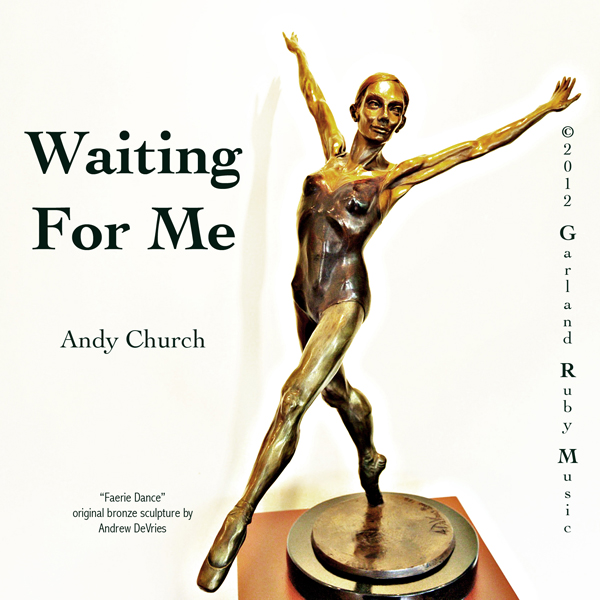
Waiting For Me
©2012 Andy Church
A tribute to my Aunt Helen, who loved beauty in all its forms, taking it in slowly and for as long as possible.
§ May 13, 2011

Sonali
©2011 Andy Church
For Sonali Rodrigues and James Tate
Everyone read the writing on the wall,
Made the letters myself and I hung them all.
Climbed the ladder high,
Loyal friends stood by,
Now the Elders want to keep me away from the ball!
So hit me up!
Sonali will you go with me?
I really want your company
Sonali please go with me to promenade.
Everybody's got opinions about the rule,
But there's no talkin' back here at this school.
They took one look at me,
And they threw the book at me...
But we all know who's right and who's the fool!
So hit me up!
Sonali will you go with me?
I really want your company
Sonali go with me to promenade.
Read it out loud!
Sonali it's a long long year
At last the summer's almost here,
Sonali please go with me to promenade.
©2011 Andrew B Church, all rights reserved
§ Aug 2, 2010
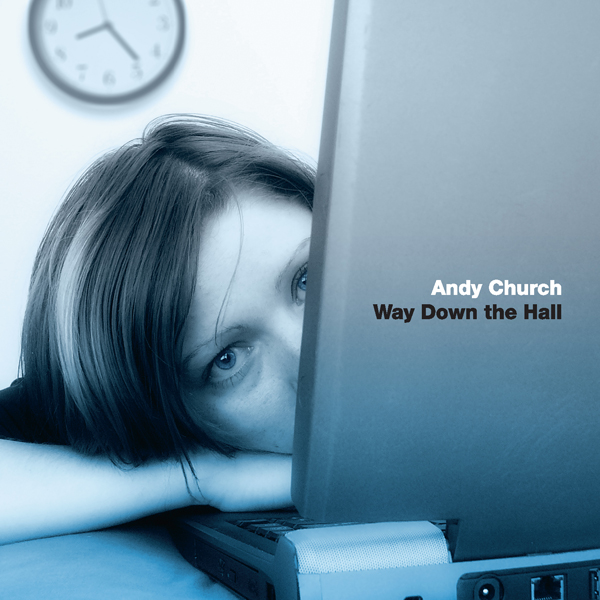
Way Down the Hall
©2010 Andy Church, all rights reserved
This song started on the conga drum… I walked into the studio one day in January and just started playing the beat. I decided to record it and see what I could make of it.
Around the same time I had the opportunity to listen closely to some raw tracks of several classic old recordings. I studied the individual tracks to see how the separate parts worked together to create the overall sound of several very well known records.
When I got back to my project, I set about weaving a rhythmic canvas of sound by recording about 8-10 different drum and percussion tracks, using congas, claves, sticks, cowbell, a screwdriver and a wrench (I did actually consider the kitchen sink)... I turned a snare drum into a timbale by removing the bottom head and putting a thinner head on top. I found some 3/8" wooden dowel stock in the basement and made myself a pair of timbale sticks (they need to be much lighter than regular drum sticks). I took the rack tom from my ludwig drum set and sat and played it with felt mallets, recalling the powerful sound of marching band toms (canons!). I triple-tracked it (recorded it 3 times over) to get a big ensemble sound.
Musically I needed some structure to hold everything together, so I ad libbed some guitar, bass, and keyboard changes over the beat to create a musical form. It was trying to sound like some sort of funk soul James Brownish thing.
Around this time, apropros of absolutely nothing, my wife Joni and I were talking about the layout of her office building, and a phrase she used to describe a colleague's location relative to her own struck me as memorable. I decided "Way Down the Hall" would be the title and the main idea for this tune I was working on. To my mind's ear the expression sounded like an apt metaphor for someone no longer riding the "pink cloud" of their job or work situation. (This is how reality gets abused by hopeless impressionists who can't stop mentally squinting at everything, turning all into something other.)
As I listened back to to the evolving track over a period of weeks in search of a melody, I recalled a set of lyrics I'd written in 1986-87 called "Good Life," a song about this exact same theme... It's Monday morning, and it's tearing me up, I'm walking in my working shoes again...
I nearly strained a muscle in my head (about an hour in a hot tub with my eyes closed trying to imagine the old lyrics superimposed over the new music... oh, and nearly as long again standing in a shower that had at some point gone cold) discovering I could indeed adapt the old lyrics to the new tune.
(The original version of "Good Life" was okay, but it was mainly a vehicle for experimenting with a sampler, nothing I would have carried forward otherwise.)
Now the challenge became to retool the music for the content - the combination of funky guitar, bass, and keyboard sounded too much like a party (of old people), not at all in agreement with the lyrics. I muted all those tracks, reverting to the rhythmic canvas, then got out the acoustic guitar and the mandolin and went all Stonehenge (as Tony later described it). I feel like this treatment made a huge difference in bringing the pieces together.
I rendered a mix and solicited a few reviews. Jeff Campbell did me the huge favor of giving it a close listen in his studio. Jeff's ears are tried and true, and his positive remarks made it easier for me to move forward with confidence.
As we studied the near complete track in the car driving to Rhode Island, Joni shared some keen and very helpful observations about the feel of the lead vocal, and I also got some excellent melodic and arrangement ideas from Tony Bowman, whom I will not mention by name.
I made the changes last week and rendered a final mix on Friday. I sent the file to Abbey Road Studios and got the master back a few hours ago.
Not a bad way to start a Monday morning...
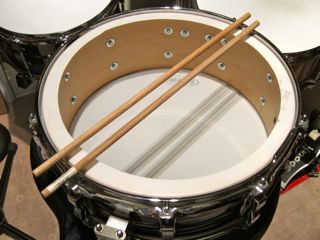
Here is my timbale, a 1998 Ludwig Maple Classic 5x14" snare drum
Snares removed, bottom head cut out
Home made 3/8" timbale sticks
§ July 13, 2010
My sister Kim says, "This should go on your blog, pictures and all!" I agree, but also with the caveat that I include a link to Jeff Campbell's new video featuring Monica Kapoor - "I Wanna Be Her."
From: jeffreyleecampbell
Subject: Re: new video
Date: July 11, 2010 11:55:37 AM EDT
To: andy church
Hey Andy
finally made it to my studio - checked out "Way Down the Hall"
sounds great! Nice catchy hook - "woh-oh-oh-oh"
I dig the all the acoustic stringed instruments juxtaposed with the timbales/world perc (nice sub freqs too)
It's got that Steve Winwood vibe (ala "Higher Love" - one of my all time fav tunes)
As far as the Lexicon - it sounds cool to me - I dunno - maybe a little wet? season to taste I guess?
I don't notice any brickwall issues - but (for better or worse) - I listen to a lot of "slammed" music
You're getting some great sounds up there - cool stuff
thanks for sharing
take care
J
www.jeffreyleecampbell.com
On Jul 13, 2010, at 9:08 AM, Kim Church wrote:
Cool. What’s “slammed” music?
Subject: Re: new video
From: andy church
Date: July 13, 2010 10:25:53 AM EDT
To: kim church

"Slammed" refers to music that has been processed heavily with dynamic compression.
In this screenshot, the blue represents audio (the top field is the LEFT channel and the bottom field is the RIGHT channel). The X-axis is time... reading from left to right you're looking at the entire song. The Y-axis is amplitude, or volume.
See how each channel looks almost like a close up of a flat top haircut? It's because the signal has been rendered at a very high volume, but electronically stopped from exceeding a predetermined maximum volume (in this case -0.2dB... absolute 0 dB is full volume, as loud as digital audio can possibly be without turning into a nasty mess.
In order to make this happen we process audio using what is typically called a "brickwall" limiter, a form of dynamics compression. It's a circuit that senses amplitude (volume) and reacts very quickly. The best brickwall limiters sound very natural and are difficult to discern.
Producers and engineers have tried for ages to make their own recordings sound louder than all the rest. Recent advances in technology have taken this approach to new heights, resulting in what is commonly referred to as the loudness war. Even with the best limiters music sounds like crap to many of us if it is too saturated with amplitude. The floor goes all the way to the ceiling and stays there, all dynamic range is sacrificed to loudness.
Since Jeff lives and works in NYC he is quite accustomed to hearing music that would look like 2 solid blue lines on this graph. Slammed. Slammed against the brickwall. Like music trying to peel itself off the wall of the Roundup at the James E. Strates Shows!

From: kim church
Subject: RE: new video
Date: July 13, 2010 10:00:20 AM EDT
To: andy church
Does that describe “Hall”?
Subject: Re: new video
From: andy church
Date: July 13, 2010 10:29:31 AM EDT
To: kim church
To some extent it describes almost every record you own, it's a matter of degree. I want my music to sound good and vibrant and full, but I don't want to use too much slamming to get there.
The perfect amount is never too far away from too much!
§ Apr 29 2010
Just finished Bill Flanagan's recent book, Evening's Empire, the fictional memoirs of Jack Flynn, lifelong manager of the members of the 60's British rock band the Ravons. Flynn's stories, dreamed up by Flanagan with lots of help from his real life music industry pals, are funny, exciting, sad, grim, nauseating, and if at times a little exaggerated, very plausible.
Many of the people and situations described in this vivid 644 pager seemed vaguely familiar. I found myself breaking away regularly to revisit my own memories of bands and gigs past, many of which I've worked for years to forget!!
Thanks to Flanagan's decades of experience as a writer, journalist, and critic (possibly you've seen him on CBS Sunday Morning), as well as holding down a day job as executive vice president and editorial director of MTV Networks, this fictional accounts reflect a lot of very real and keen perspective - band relationships, family, life on the road, encounters with the law, dynamics in the studio, evolving technology, songwriting, ego, money, sex, clothes, hair, drugs, promoters... all the stuff that musicians deal with everyday, usually with limited success.
When I finished the book a few days ago all I could do was to put it down and say, "hmm... no doubt!"
Highly recommended for your summer reading... Thank you Cleveland, Good Night!!

Simon & Schuster, January 2010
Hardcover, 656 pages
ISBN-10: 1439148457
ISBN-13: 9781439148457
§ Apr 3 2010
Pedalboard Junior
3 decades of countless stomp box experiments have led me to this very simple and elegant solution for dialing in my personal ideal electric guitar tone. I built this desert island pedal board (from solid oak) this past week to keep at our cottage in RI.
Signal flows right to left:
1) David Barber TONE PRESS - excellent dynamics control with unique BLEND feature for parallel compression
2) Way Huge PORK LOIN - soft clip injection overdrive with parallel clean boost by George Tripps
3) Chad Matthews DEEELAY - analog delay using bucket brigade design for warmth and character


§ Mar 25 2010
Paul Patronete of Mercury Magnetics is remarkable... his understanding of amplifier circuitry is eclipsed only by his enthusiasm for talking with musicians. Thanks to the time Paul took explaining a few things to me I've made some improvements to my amplifier that will not only improve the sound quality but will extend the life of my old GE power tubes and everything connected to them.
Similarly, Darrell Young in Carrboro, NC, is perhaps the friendliest most upbeat amp technician on the entire east coast. Thanks Darrell!
§ Mar 24 2010
Family and friends have come calling for two weeks in a row, reminding us of the special and unique quality our area has to offer, and more importantly how wonderful it is to have people in our lives who go to the trouble to make their way here to visit us.
http://www.flickr.com/photos/45130673@N07/sets/72157623559208137/
http://www.flickr.com/photos/45130673@N07/sets/72157623685877650/
http://www.flickr.com/photos/45130673@N07/sets/72157623685892930/
§ Feb 28 2010
Winter has been a time of woodshedding, continuing to develop recording methods and explore the nuance of various combinations of mics and preamps, hardware and software circuitry, etc.
Today though I'm taking a serious at our family's banking relationships. If you're at all interested in shifting your money from a mega monster bank to a local or regional bank, try this tool.
Move Your Money Join the Sea Change |
§ Jan 21 2010
Good habits are hard to establish. I will tend to my journal, I will tend to my journal, I will tend to my journal...
Back in the studio after the usual yearly forced exhile (into the loving arms of family). Nothing ready to share yet, but continuing improvements in my understanding & techniques are taking me closer to the sound I'm after.
Meanwhile I was in and around a couple very interesting discussions this Tuesday, Jan 19.
First I had the great pleasure to spend the afternoon with Jay Newland, the highly regarded engineer and producer who found himself in the spotlight a few years ago when he won 4 Grammy awards (2003) for his work recording and producing Norah Jones' Come Away With Me. (As it happens, Jay has been nominated again this year for his engineering work on Leslie Mendelson's Swan Feathers.)
I first met Jay in 2007 just after he'd finished work on Abbey Lincoln's beautiful record, Abbey Sings Abbey. (Do yourself a favor and buy this one.) I'd heard of him since Ifirst moved to Rowayton in 2004 from my best new buddy Craig Spinney, who was well-acquainted with Jay's work, even to the extent that he had a good sense of Jay's very straightforward jazz and blues based recording approach (source moves air across microphone, preamp passes signal into recording device). Jay's influence on me began with that first conversation with Craig, almost 3 years before I would ever meet him. Over the months as I created my new workspace, I modeled it to accomodate what I thought to be a similar approach, shifting my emphasis back toward traditional recording (as opposed to midi and electronics). A term I'd had in mind since college was finally relevant to my work - audio verité - true sound.
In June of 2007 Craig called and told me he was working some sort of guitar trade with Jay, and asked if I would like to go with him to Jay's home. With Jay's permission I went with Craig to his house where we found him sitting on his front porch steps examining some hard drives containing files from his recent recording sessions with Richie Havens. Fed Ex had just delivered the drives, and Jay was about to start work on the mix. He was gathering his thoughts, getting ready to go deep into that place where mixing engineers go to make a record from miles of tracks.
In retrospect the timing probably couldn't have been better. Jay was at a transition point in the Havens project, preparing to mix after lots of tracking (a rare lull in production for someone who wears so many hats), and I think our morning-long shop-talk bs session really came at a welcome time. I've maintained a loose connection with Jay ever since, mostly through email and occasional visits during set breaks of his band VooDoo Carnival. It's a matter of record that our discussion about his prized Steve Carr Vincent guitar amp set me in motion building my own amp inside the chassis of a Deluxe Reverb Reissue. The energy of our interaction, from that first meeting on, is at the center of what brought Jay and I together again to talk this week.
I love my workspace, and nothing will ever replace what having that space does for me musically. But as the home studio has emerged as the prevailing production environment, so has the larger studio disappeared from the landscape, and recording enthusiasts of all levels are finding fewer reasons to leave the house. Simultaneously, gear acquisition is no longer an activity that requires getting into a car - much to the dismay of the legions of guitar shop professionals who found themselves looking for other ways to make a living, many after lifetimes of dedication. And not just for the guys who worked there, but the near extinction of the local combo shop has also been a blow to the multitudes of neighborhood kids and would-be rockers, who once upon a time could count on running into one another roaming the flat black and dirty carpet of the aisles and peering through the fingerprints and bumper stickers of the glass stomp box cases.
For active touring musicians, opportunities to mix it up with others and add their marks to the layers of graffiti on dressing room walls abound, but for an increasing number of us home studio hermits, more and more of our musical experience happens in a vacuum, and all our interaction is reduced to online guitar lessons, stupid blogs like this, and posts on facebook and twitter.
Of course part of the problem is that we can't trust other musicians enough to let them into our homes, or said differently, we can usually trust musicians to be the kind of people we wouldn't invite into our homes. "I don't want these guys near my toothbrush," as a friend so elegantly told me last week. Of course, we've all done things to damage our own collective image and validate this unfortunate generalization, but the truth is we are really the only victims. What exists among us now is a sort of studio détente, in which we mostly upload and download files created in the safety of our separate spaces, which feels a bit like using those wonderful pneumatic tubes at the drive-in window of a bank, or booking travel at the train station ticket counters in Florence, where you put your money in a stainless steel drawer and attempt to communicate thorugh a little air vent.
These and other similar ideas have been creeping into my head lately. I think what really called it to the front was when renovation work began recently on a nearby commercial building that has been boarded up since I moved here. I've always thought that place would be a great setting for some kind of musical enterprise, and to see it suddenly spring to life has prompted me to sort my thoughts more carefully and try to get a reading on exactly what I would even propose.
Meanwhile, through the grapevine (or the day spa as Fairfield County would have it), I found out Jay Newland has also had his eye on that same building for similar reasons. It's really not a surprise at all... if you saw it, you'd think the same thing... that would be a great place for some sort of studio. I contacted Jay last week and he admitted he's always been intrigued by the notion, and more generally by the prospect of creating a space outside his home, but the details had never come together. We decided it would be fun to have lunch and knock around ideas. I won't go into all that was said (other than what I already have), but we both agree that there are tons of advantages to being part of a shared production space, a place where people come together to work on their music.
For me this is not about speed, it's about quality, so don't expect to tune in and read about our new studio anytime soon. Something may take shape at some point, but who knows what it might look like? Would it be a place for tracking, mixing, performing... there is really no telling. Mainly the idea is that we miss having a reason to leave the house, and our world could use more places where musicians go to work together.
Then again, maybe we just found that, in the form of a friendship that is taking shape exactly because of the way our environments have evolved.
Please don't let me forget, I also wanted to tell you at least a little about the NARAS seminar I attended Tuesday night with Bill Flanagan (music journalist, MTV exec, regular contributor to CBS Sunday Morning) interviewing Steve Lillywhite (Ultravox, U2, XTC, Peter Gabriel, The La's, Dave Matthews Band, Phish, many more).
Honestly, it won't take long, so I'll get it in here. I can't recall ever knowing or being aware of anyone with better stories than Steve. He and Bill spoke for over 2 straight hours to a group of about 75 attendees and it was absolutely riveting.
I can't even start to describe it, you should just listen for yourself sometime to episodes of the Lillywhite Sessions at www.eastvillageradio.com.
I will share some of what was said during the evening's final topic, though, which I found quite fitting given the way I'd spent my afternoon. Forgive the paraphrasing.
Bill asked Steve how he thought the music industry might find its way out of the mess it's in.
Steve said in his opinion the damage has been done and is irreversible. Steve's a very fun-natured guy, very "chappy" as he puts it, but for this question he got red in the face and was clearly agitated. He said something to the effect that "they had our shit in their stores... it's bad enough that they own all the work we do, but, okay, that's the deal, that's fine... but they had all our shit in their stores, and instead of putting a fucking guard at the door to keep people from running off with our shit, they decided to save the money... I saw them, I mean I watched them do it... they decided to save the money it would cost to have people guard our shit, so they could make their bonuses... and now all our shit's been run off with, and there's not a bloody thing anybody can do about it."
Someone in the audience said "so what can we do?" In a most illuminating and inspiring response, Steve said people should keep being musicians, and keep making music. He and Bill agreed that in the history of man there has only been a little blip of about 50 years or so in which people ever made big money in music. He said he believes strongly in the culture of studio, and what happens when people share energy, ideas, and talent in a studio setting.
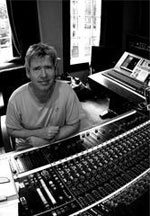
You should listen to Steve Lillywhite yourself.
Working with U2 / Working with Peter Gabriel / Working with the Dave Matthews Band / Working with the La's
§ Dec 14 2009
Sorry my entries here have slowed lately, partly because of holiday travel, but mainly as the result of some intense woodshedding here in the studio. As is often the case, a quickly recorded song takes much longer to tweak and finish to my satisfaction. Part of the challenge is to avoid letting the additional production crush all the fun and vibe out of a track, but yet, also in the spirit and tradition of making rock music, it is important not to put too tight a leash on the whole process. It's a balance everyone weighs for themselves.
Lots of thought and mad science went into finalization of "Buddha Buddha," and I made several remarkable discoveries along the way.
First, did you already know that thumping on an empty 500ML plastic San Pellegrino bottle produces a nice round percussive sound tuned to an almost perfect F#? I had an empty on my desk, and everytime I moved it aside while the track was playing I noticed it was in tune with the song. After a while I realized the bottle belonged in the mix, so I opened a new track and recorded it through the CM7>LA2A chain I had set up for vocals. It settled right into the mix with no additional processing other than to apply some low frequency rolloff. (F#2 is a wave that is over 12 feet long... don't want too much of that running loose!) Listen closely on beats 1 and 3 of the verses. The sound of the bottle is masked by the acoustic guitar playing the same note, but it's mixed fairly up in volume. To my ear it reads as extra energy, helping to suggest the slow steady puttering of an old steamboat.
Another cool thing was using the Cascade Fat Head II and Shure SM 57 as seen below to record electric guitar. In addition to the close mics I also set up the Cascade Vin Jet about 4 feet away. I had to be careful to keep all 3 mics in phase, and with 2 figure-8 ribbons I still wasn't sure what to expect. Too many mics can screw up the sound real fast, but in this case there was a noticable improvement when the Vin Jet was engaged. Hard to describe, but more real and 3-dimensional are words I would use if I were to try. This guitar sound is especially effective at the end of the song, which I think works much better in a number of ways now.
I'd been a little confused by the identity of the electric guitar phrases during the choruses. I originally played that part using the bridge humbucker of the Parker Fly, through my Deluxe, taking the speaker out of the amp directly into pro tools by way of the Ted Weber Mini Mass speaker attenuator, and then runningthe signal through speaker simulation software (Digidesign's Eleven). I liked the energy and a lot about the sound, and I'd been curious to experiment with that hybrid signal path, but it just wasn't yet a sound that I felt represented me. Then one morning last week I heard some Tom Petty on the radio and it dawned on me that the sound of a 12-string was always a big driving force for me growing up, a sound I really identified with, and one that would fit well into this song.
I don't keep a 12-stringer around these days, so I put a capo on the 14th fret of the Parker Fly and double tracked all the original parts one octave higher (this time using microphones). It lends a brilliant chiming quality to those phrases, and with separate tracks I had much better control of the mix. Also, played on a real 12 string a lot of those phrases would have lost the upper register because of the way those guitars are tuned, so in this case there is an advantage of having the upper register throughout the track. In any case, it's now a sound that I personally relate to (thanks to Danny Burkhart, Neb Rodgers, and Lee Lohr).
Last but of much greater interest, I have finally made good on my declared intention to take a project to Abbey Road Studios for mastering. This past June Joni and I were in London, and one afternoon I walked all the way up from Piccadilly to St. John's Wood and 3 Abbey Road, mainly just to see it for myself, but also to discuss the possibility of using their mastering services. It's a lovely spot, in fact just around the corner from the parents of our friend Will Morris, and I was greeted with a cheerful kindness that suggested to me that some very good energy floats within those walls. I was given some printed material, rate sheets, contact info, and assured that no project was too small. In the months since then I've had to contact Abbey Road for some help with a few plugins I use, and again they were quick to respond, very pleasant and helpful.
Now Abbey Road has established an online mastering service, allowing clients to manage files and projects using the internet. Friday afternoon I rendered my final mix of Buddha Buddha, and over the weekend I uploaded the file, drafted a few notes for the mastering engineer, and placed the order. This morning at 8:30 I have a mastered track! As I listen to it side by side with my own mastered version (I create very neutral mixe,s so I have to do some basic mastering and eq sculpting just to listen in the car) I must say it is exactly what I was looking for in a mastering service. What a great feeling, to put everything one has into creating something special, and then to turn it over to capable experts who go on to extract from that a beautiful finalized version of the work. I almost always experience some degree of disappointment with mastering, but not this time, in fact quite the opposite. I'm just amazed! ★★★★★
"Buddha Buddha"
Sound Recording by Andy Church, ©2009
Written by R W Miller, ©1982
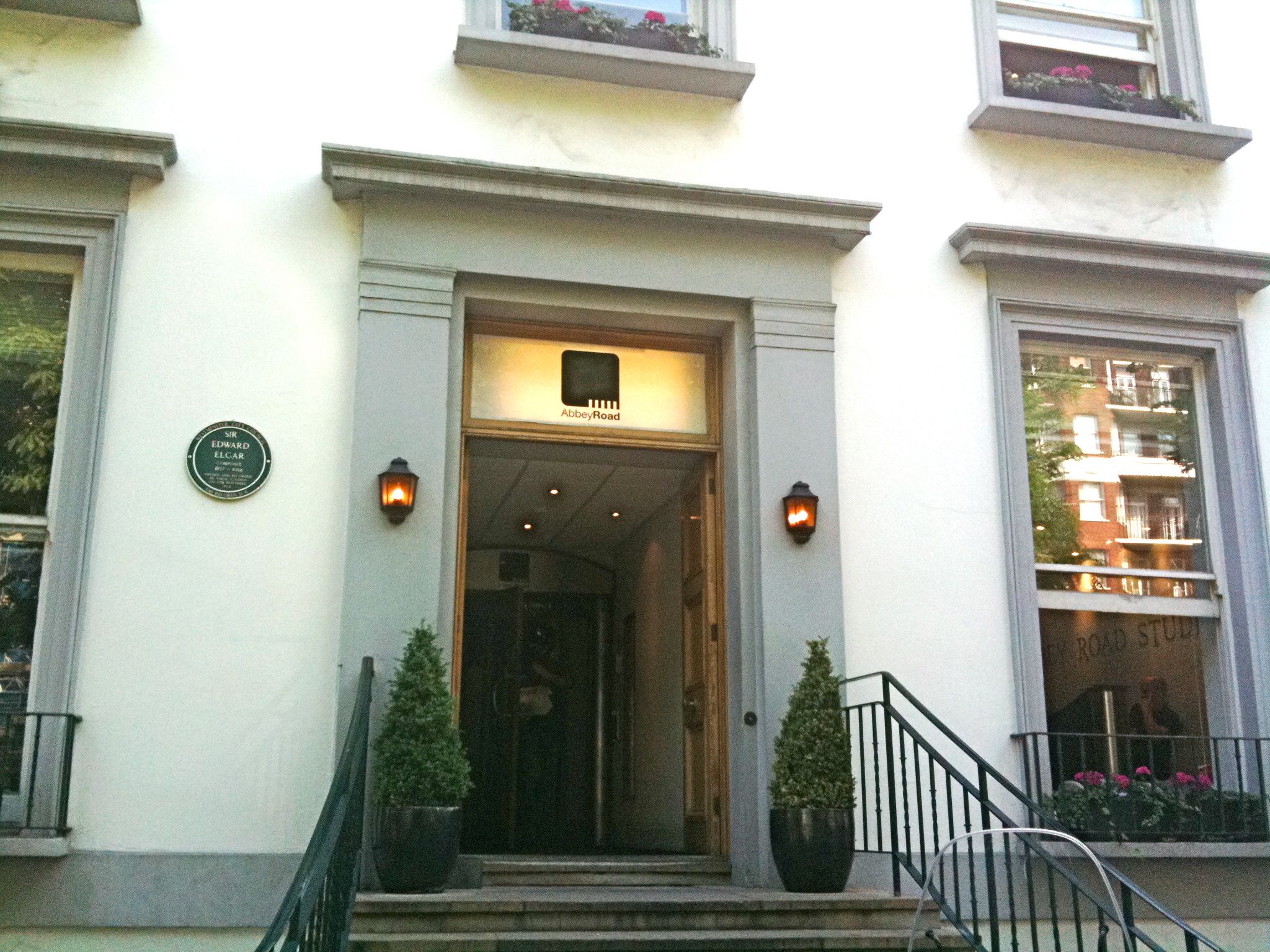
§ Nov 19 2009
Moving over to electric guitar this week, working on recording a different sound. Not my usual tone, but one with which I'm very familiar. I find my way to this sound often when working out, I wanted to learn to get it right and record it well.
Again the Fat Head II ribbon mic really shines on this application. Situated by an SM57, phase aligned, and both running through Great River pre amps directly to disk. I no longer miss my Royer 121.
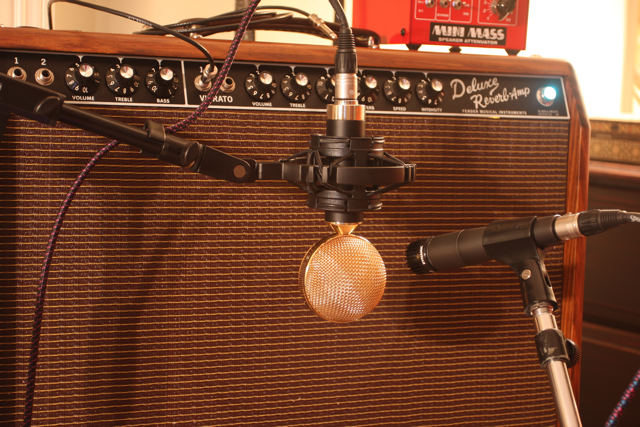
This setup sounds great. The mutual reinforcement produces a surprisingly thick full tone. I'd intended to also mic up the bottom closed back cab for more beef, but it's really not needed. In fact I think it is more reliable to keep these mics very close together so all the moving air pushes and pulls in unison. When I solo either mic by itself it sounds pretty good, but both together >>> the sum of the parts!
This is one guitar, one pass.
Sound Recording ©Andy Church, 2009
Today was casual Thursday here at Garland Ruby Music!

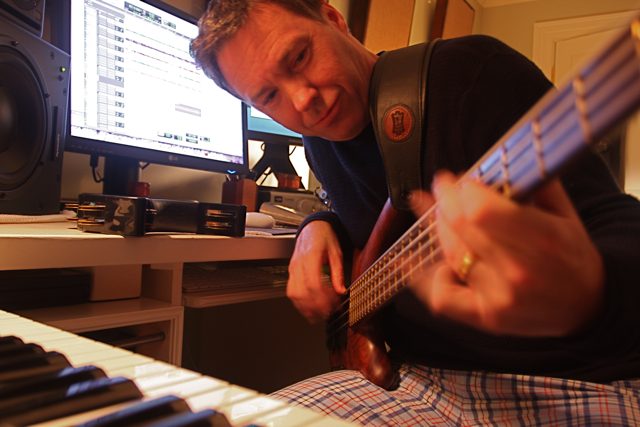
§ Nov 12 2009
Working with Mid-Side microphone technique today, recording acoustic guitar with a Neumann KM 84 and a Cascade Fat Head II. Woke up dreaming about how to do this, decided it must be done. The KM84 underneath provides the center, the Fat Head above provides a wide left and right stereo image. Fullness without double-tracking.
§ Nov 4 2009


Buddha Buddha
Words and Music ©1982 Richard W. Miller
Sound Recording ©2009 Andy Church, all rights reserved
One afternoon a few months ago while Joni (XΩ) and I were in Little Compton, I was making some noise with an acoustic guitar, and out of nowhere I started playing a slow version of "Buddha Buddha", the old Rick Rock song that made a splash for us back in 1982 when it was included in the Dolphin Records compilation album Mondo Montage. XΩ liked it and said I should record my own version of the song.
I didn't give it much thought until week before last, when it happened again, and again she suggested putting it on record, so I figured maybe I should give it a go.
I made this recording on Nov 2 & 3 in what turned out to be a couple very productive sessions, going about things a little differently than I have in the past. I set up 6 microphones in a circle around my chair (which I soon replaced with a swivel drum throne), hooked up and configured each mic depending on what I intended to do with it, and fired them all up at once. I set some guitars and drums and harmonicas where I could get to them and started tracking from scratch, feeling my way toward a sound and an arrangement.
Things got tangled and cluttered as I dug deep into the process, spinning from mic to mic, swapping one instrument for another, then turning back to the desk to man the pro tools rig. At times I literally had myself roped in and could not get out! I managed not to panic, though, and luckily the only thing I broke was a headphone cable. Those things are designed to fail anyway, though, they are such crap.
Having an array of mics up and running isn't exactly a new idea, but having them all circled near the controls is certainly new for me. OMB production (one man band) is challenging, often absolutely overwhelming. By bringing all the mics over to the desk and keeping them plugged in and set I was able to switch instruments without having to waste time switching mic setups. This really helped keep my mind on the music, and it also kept my hands and voice warm, all of which meant that ideas became recorded tracks in minutes instead of hours.
This project sprang from sparse noodlings on a lone acoustic, but once underway the arrangement took on a life of its own. As I've told people before, much of my time in the studio is spent creating parts that I can almost already hear. I was surprised by the apparent need for harmonica, but there it was, loud and clear in my mind's ear, not to be denied.
Getting the harp solos recorded was especially fun and ridiculous. Of course, I can't play worth a damn, I mostly just blow and suck, but I stood next to Carter Minor for 5 years, and that guy CAN SO play, so I know what it's supposed to sound like. I used my own version of a chromatic harmonica - 2 harps, one in each hand, keys of F# and B. Lots of blowing, sucking, wheezing, and plenty of punching in, which I can do all day long. That's my secret for a wailing harmonica solo. Anybody can do it. And that big mic is truly a wunder .
What you hear is just me and a pile of instruments and mics in our spare bedroom. Hope you dig. Ohmmmm.
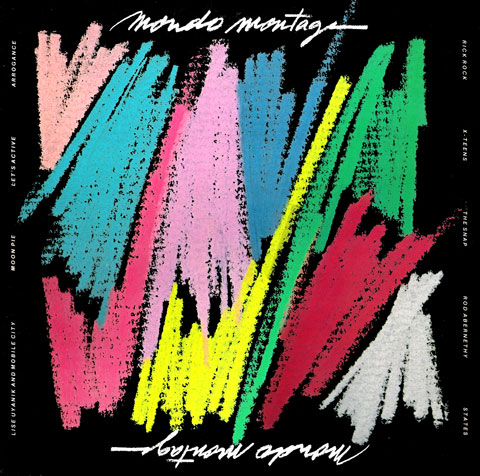
For the record, all rights are protected by law - unauthorized use or reproduction is expressly off limits.
I found these comments on various discussion boards.
I'm glad I am not the only one on this ng to own (and maintain a fondness for) Mondo Montage.
After reading a post about Mondo Montage last night, I heard "Buddha Buddha" on XYC this morning, and was reminded afresh how utterly cool that song was when it came out.
"Buddha, Buddha" has become a source of regional pride since the song itself was included on the now long out of print Mondo Montage compilation back in the 80s. The song has since been recorded by a variety of artists from Tina Turner to some ex-Squirrel Nut Zippers who cut a version for the recent Sixty Five Roses benefit CD.
I really should document the setup, so I will do it here. You have permission to skip this part!
Wunder CM7 (U47 clone) > API pre (11 o'clock) > Cranesong STC-8 compressor ( A mod, preset A / var rel set to 0). Vocals, harmonica.
Neumann KM 84 > Great River pre (gain 35, x-former loaded) > Universal Teletronix LA2A. Martin D18GE, Remo squash veggie shaker, hand claps.
Brauner Phantom > Great River pre (gain 30, no loading) > Universal 1176LN. Djembe, Parker Fly Mojo through custom 65 deluxe reverb.
Shure SM57 > API . Ludwig Black Beauty.
AKG C451EB > Universal Solo/610 pre > Cranesong STC-8. Paiste 602 14" hi hats, Wuhan 16" china, Zildjian K 20" ride.
Audio-Technica 4047/SV > API. Ludwig 20" classic maple bass drum.
Warwick Thumb Electric Bass recorded direct to disc through API preamp.
§ Oct 24 2009
This past Monday I had the pleasure and honor to attend the first ever Producers' Panel event at Avatar Studios on W 53rd St in New York, the last remaining major recording studio in Manhattan. Housed in what was originally a Consolidated Edison power plant and subsequently used to stage television's Let's Make a Deal, the studio itself is legendary. Tony Bongiovi adapted the space for audio recording in 1977, opening it as The Power Station, and known by that name and then as Avatar since a change of ownership in 1996, it has been the birthplace of some of the best records ever made.
Monday night's panel included Steve Lillywhite, Roy Hendrickson, and Kevin Killen. There were about 75-80 attendees, mostly indie artists and producers, many of whom were in the city for this week's CMJ Music Marathon and Film Festival. The discussion covered a range of topics, from technical issues, such as working with digital audio, arranging to grids, and cutting to click tracks; to more subjective concerns, like managing personalities, egos, track count and workflow; to even broader matters, such as sorting through and choosing songs, projects, even bands. All three producers seemed quite at ease with one another, giving the discussion a quick pace and a great blend of thoughtfulness, candor, and good humor that made it all a lot of fun and very enlightening.
After the panel was thanked and adjourned, names were drawn from a jar, and the winners would get to sit down for a private 15-minute consultation with one of the three panelists. I was lucky enough to be the last person to win the incredible opportunity to sit down with Steve Lillywhite. I hadn't shown up to this event with much of an agenda... certainly not a burning desire to make the kind of hay I suspected some of the others were after that night. I decided instead of angling for advancement I would just use the time to thank my esteemed host, let him know I loved and admired his work, and give him the rest of the evening off.
But as soon as I introduced myself and took a seat, I found him to be such a likeable guy... genuinely warm and bright... that I forgot all about about my plan to let him off the hook! I started in with "how's Andy Partridge these days?" (XTC), and from there conversation flowed fairly naturally, wending and wandering steadily along under its own momentum.
I noticed that everyone before me had given Steve cds of their music that were by this point stacked into a twisted pile, waiting there on the table, looking a little desperate. I decided to hold off making it even more so with mine. Of course it's possible he brought all those himself to discourage unsolicited submissions, but it didn't matter, because I really didn't want anything I hadn't already gotten from 30 years of listening to his records and 40 minutes of listening to him discuss record making. However, since I had gone to the trouble to print a few just for the event, I did give him my card, and he got a good laugh at my slogan, "Since 1960!"
15 short minutes later, about the time I'd decided to start angling for a job, one of Avatar's production assistants approached us and gave me the rest of the evening off. Steve and I shook hands, cheers'd each other goodnight, and I floated down the stairs, out the door, and up the street to the Nose Bar on 7th Ave for a strong martini!
I hope Mr. Lillywhite doesn't mind, but I gave what would have been his copy of Sleeping in the Van to Cynthia, the head bartender at Trattoria Dell'Arte, one of New York City's very best.
That, in as few words as I can tell it, was my Monday night... not bad, but it sure screwed with my head Tuesday.
§ Oct 23 2009
I'm renewing my resolve to spend time posting to this site. Because social networking is so prevalent and multifaceted, a person can spend an awful lot of time just keeping up with activity on MySpace, Facebook, and Twitter. That's all great, and I really am happy to be in touch with so many of my good friends from all over creation, but as for my ongoing work in music, I think I will opt to place more emphasis on andychurch.com instead of anything Mark Zuckerberg or the likes have provided. I have no real control over any site that is not truly mine.
Since the previous post in February we made some good progress promoting Sleeping in the Van, thanks to the help of David Avery and his company, Powderfinger Promotions, based in the Framingham section of Boston. The cd was picked up by a total of 64 college and community radio stations, and I suspect there may have been a few more that did not file with our reporting service, such as WTMD 89.7 FM at Towson University, serving Baltimore and DC. (Disappointingly we have not yet found our way onto the air at WFUV in the Bronx, but we must be patient and remember they are overwhelmed beyond measure by thier own success and popularity. I hope they will not be unduly alarmed that Mr. Lillywhite now knows of their existence!)
Here is the actual Radio Tracking Report for Sleeping in the Van, for anyone who would like to take a look.
This past summer was a time of extensive retooling for me, so writing and recording took a back seat. Most of the work was highly technical and not really worth describing, with one exception.
The Fender '65 Deluxe Reverb Reissue amp that I rebuilt from the ground up last year now has a new home inside a gorgeous antique pine open-back cabinet (with matching close-back extension cabinet). Bob Burt did an outstanding job building both cabs from wood that he salvaged from a 100-yr-old barn in Arkansas left to him by his grandfather. This amp has great tone and response, and the additional 12" speaker enclosure adds body that most amps of this size can't acheive.
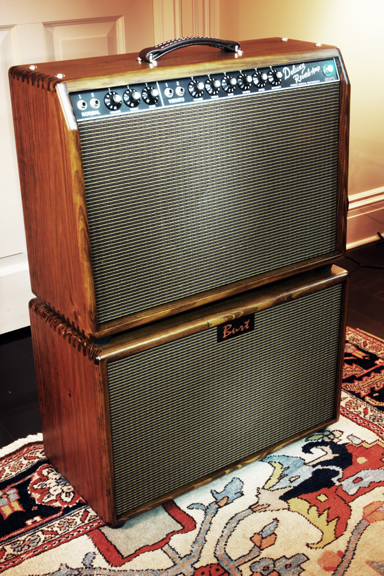
Details: Hoffman AB763 circuit board, assembled and populated by Robert at the Airtight Garage in New Iberia, LA. All transformers by Mercury Magnetics. Open-back Alnico 12" Speaker 12A150 by Ted Weber. Closed-back Ceramic 12" Speaker 12F150 also by Weber. Select vintage nos tubes, including a 1966 Mullard 5AR4 rectifier.
§ Feb 11, 2009
First off, thanks to everyone who has bought Sleeping in the Van (in many cases numerous copies for distribution among friends and family), then actually listened to the songs and reported back to the artist. After muttering to myself for hundreds and hundreds of hours on end during production (studio work is just like office work, only it's boring) I'm absolutely over the moon to hear back anything at all in the way of an audience response. Keep those letters coming!
A number of strong supporters (Keys to the Van Club) pledged contributions to WFUV 90.7 FM (Fordham University Radio, the Bronx) last week during all-request Friday in an effort to nudge the nice on-air talent there into spinning some Andy Church tunes over the waves. Posted playlists indicate the cd is yet to get out of the station in the preferred way. Yet I feel sure our/your little seed of a suggestion is taking root, one that will eventually bear fruit, so by all means please continue to let them hear from you.
Rita Houston is the music director. Email your request to thefolks@wfuv.org.
In technical news, I built a new pedalboard last week for my guitar effects. I've found a great way to combine 3 overdrive pedals in series for an outstanding variety of tones. Thought you'd want to know. And were you aware that I completely rebuilt my Fender '65 Deluxe Reverb Reissue amp last year? I'm happy to report it still works (rocks, even... hard!). Thought you'd want to know that as well.
